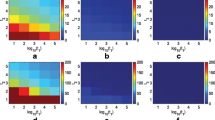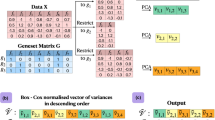Abstract
An effective data mining system lies in the representation of pattern vectors. For many bioinformatic applications, data are represented as vectors of extremely high dimension. This motivates the research on feature selection. In the literature, there are plenty of reports on feature selection methods. In terms of training data types, they are divided into the unsupervised and supervised categories. In terms of selection methods, they fall into filter and wrapper categories. This paper will provide a brief overview on the state-of-the-arts feature selection methods on all these categories. Sample applications of these methods for genomic signal processing will be highlighted. This paper also describes a notion of self-supervision. A special method called vector index adaptive SVM (VIA-SVM) is described for selecting features under the self-supervision scenario. Furthermore, the paper makes use of a more powerful symmetric doubly supervised formulation, for which VIA-SVM is particularly useful. Based on several subcellular localization experiments, and microarray time course experiments, the VIA-SVM algorithm when combined with some filter-type metrics appears to deliver a substantial dimension reduction (one-order of magnitude) with only little degradation on accuracy.











Similar content being viewed by others
Notes
For such a huge dimensionality, a preliminary Signal-to-Noise ratio (SNR)-based filtering method can be applied to weed out those k-mers patterns (i.e. columns) that are below certain low threshold.
In addition to the SNR-type filter and SVM-RFE, there exist an extremely large number of application studies based on microarray data. Two recent ones are the MRMR [38] and Markov blanket [39], which are based on the Multivariate techniques. Another recent approach is the VIA-SVM [40], which is more amendable to the self-supervised scenario explained in Section 6.
Downloadable from the official site http://www.genome.wi.mit.edu/mpr
Here, we use bold face to represent both vectorial data such as gene expression profiles and non-vectorial data such as sequences.
References
Guo, J., Mak, M. W., & Kung, S. Y. (2006). Eukaryotic protein subcellular localization based on local pairwise profile alignment SVM. In 2006 IEEE international workshop on machine learning for signal processing (MLSP’06) (pp. 391–396).
Reinhardt, A., & Hubbard, T. (1998). Using neural networks for prediction of the subcellular location of proteins. Nucleic Acids Research, 26, 2230–2236.
Pavlidis, P., Weston, J., Cai, J., & Grundy, W. N. (2001). Gene functional classification from heterogeneous data. In Int. conf. on computational biology (pp. 249–255). Pittsburgh: PA.
Leslie, C., ESKIN, E., & Noble, W. S. (2002). The spectrum kernel: A string kernel for SVM protein classification. In Altman, R. B., Dunker, A. K., Hunter, L., Lauredale, K., & Klein, T. E. (Eds.) Proc. of the pacific symposium on biocomputing. River Edge: World Scientific.
Leslie, C. S., Eskin, E., Cohen, A., Weston, J., & Noble, W. S. (2004). Mismatch string kernels for discriminative protein classification. Bioinformatics, 20(4), 467–476.
Ben-Hur, A., & Brutlag, D. (2004). Sequence motifs: Highly predictive features of protein function. Neural Information Processing Systems 2004.
Kuang, R., Ie, E., Wang, K., Wang, K., Siddiqi, M., Freund, Y., & Leslie, C. (2004). Profile-based string kernels for remote homology detection and motif extraction. Computational Systems Bioinformatics Conference, 2004. CSB 2004. Proceedings. 2004 IEEE (pp. 152–160).
Gao, Q., & Wang, Z. (2006). Feature subset selection for protein subcellular localization prediction. Lecture Notes in Computer Science, (Vol. 4115, p. 433).
Su, Y., Murali, T. M., Pavlovic, V., Schaffer, M., & Kasif, S. (2003). RankGene: Identification of diagnostic genes based on expression data (vol. 19). Oxford: Oxford University Press.
Kung, S. Y., & Mak, M. W. (2008). Feature selection for self-supervised classification with applications to microarray and sequence data. IEEE Journal of Selected Topics in Signal Processing: Special Issue on Genomic and Proteomic Signal Processing, 2, 297–309.
Huang, C., Lin, C., & Pal, N. (2003). Hierarchical learning architecture with automatic feature selection for multiclass protein fold classification. NanoBioscience, IEEE Transactions on, 2, 221–232.
Kohavi, R., & John, G. H. (1997). Wrappers for feature selection. Artificial Intelligence, 97(1–2), 273–324.
Golub, T. R., Slonim, D. K., Tamayo, P., Huard, C., Gaasenbeek, M., Mesirov, J. P., et al. (1999). Molecular classification of cancer: Class discovery and class prediction by gene expression monitoring. Science, 286, 531–537.
Kudo, M., & Sklansky, J. (2000). Comparison of algorithms that select features for pattern classifiers. Pattern Recognition, 33(1), 25–41.
Simon, R. (2003). Diagnostic and prognostic prediction using gene expression profiles in high-dimensional microarray data. British Journal of Cancer, 89(9), 1599–1604.
Hastie, T., Tibshirani, R., Eisen, M., Alizadeh, A., Levy, R., Staudt, L., et al. (2000). ’Gene shaving’ as a method for identifying distinct sets of genes with similar expression patterns. Genome Biology, 1(2), research0003.1–research0003.21.
Ding, C. (2003). Unsupervised feature selection via two-way ordering in gene expression analysis. Bioinformatics, 19(10), 1259–1266.
Varshavsky, R., Gottlieb, A., Linial, M., & Horn, D. (2006). Novel unsupervised feature filtering of biological data. Bioinformatics, 22(14), e507–e513.
Golub, G. H., & Loan, C. F. V. (1996) Matrix computations. Baltimore: Johns Hopkins University Press.
Steinbach, M., Ertöz, L., & Kumar, V. (2003). The challenges of clustering high dimensional data. In: New vistas in statistical physics: Applications in econophysics, bioinformatics, and pattern recognition. New York: Springer.
Guyon, I., Elisseefi, A., & Kaelbling, L. (2003). An introduction to variable and feature selection. Journal of Machine Learning Research, 3(7–8), 1157–1182.
Tamayo, P., Slonim, D., Mesirov, J., Zhu, Q., Kitareewan, S., Dmitrovsky, E., et al. (1999). Interpreting patterns of gene expression with self-organizing maps: Methods and application to hematopoietic differentiation. Proceedings of the National Academy of Sciences, 96, 2907–2912, Mar.
Kohane, I. S., Kho, A. T., & Butte, A. J. (2003) Microarrays for an integrative genomics. Cambridge: MIT.
Xing, E., & Karp, R. (2001). CLIFF: Clustering of high-dimensional microarray data via iterative feature filtering using normalized cuts. Bioinformatics, 17(90001), 306–315.
Roth, V., & Lange, T. (2004). Bayesian class discovery in microarray datasets. Biomedical Engineering, IEEE Transactions on, 51(5), 707–718.
Niijima, S., & Okuno, Y. (2008). Laplacian linear discriminant analysis approach to unsupervised feature selection. IEEE/ACM Transactions on Computational Biology and Bioinformatics, 10, 20 Oct. doi:10.1109/TCBB.2007.70257.
He, X., Cai, D., & Niyogi, P. (2005). Laplacian score for feature selection. Advances in Neural Information Processing Systems, 18, 507–514.
Wolf, L., & Shashua, A. (2005). Feature selection for unsupervised and supervised inference: The emergence of sparsity in a weight-based approach. The Journal of Machine Learning Research, 6, 1855–1887.
Li, H., Jiang, T., & Zhang, K. (2006). Efficient and robust feature extraction by maximum margin criterion. Neural Networks, IEEE Transactions on, 17, 157–165.
Fukunaga, K. (1990). Introduction to statistical pattern recognition. London: Academic.
Alon, U., Barkai, N., Notterman, D., Gish, K., Ybarra, S., Mack, D., et al. (1999). Broad patterns of gene expression revealed by clustering analysis of tumor and normal colon tissues probed by oligonucleotide arrays. Proceedings of the National Academy of Sciences of the United States of America, 96(12), 6745.
Armstrong, S., Staunton, J., Silverman, L., Pieters, R., den Boer, M., Minden, M., et al. (2002). MLL translocations specify a distinct gene expression profile that distinguishes a unique leukemia. Nature Genetics, 30(1), 41–47.
Fauquet, C., Desbois, D., Fargette, D., & Vidal, G. (1988). Classification of furoviruses based on the amino acid composition of their coat proteins. Viruses with fungal vectors (pp. 19–38). Wellesbourne: Association of Applied Biologists.
Pomeroy, S., Tamayo, P., Gaasenbeek, M., Sturla, L., Angelo, M., McLaughlin, M., et al. (2002). Prediction of central nervous system embryonal tumour outcome based on gene expression. Nature, 415(6870), 436–442.
van ’t Veer, L. J., Dai, H., van de Vijver, M. J., He, Y. D., Hart, A. A. M., Mao, M., et al. (2002). Gene expression profiling predicts clinical outcome of breast cancer. Nature, 415, 530–536.
Beer, D. G., Kardia, S. L., Huang, C.-C., Giordano, T. J., Levin, A. M., Misek, D. E., et al. (2002). Gene-expression profiles predict survival of patients with lung adenocarcinoma. Natural Medicines, 8, 816–824.
Khan, J., Wei, J. S., Ringner, M., Saal, L. H., Ladanyi, M., Westermann, F., et al. (2001) Classification and diagnostic prediction of cancers using gene expression profiling and artificial neural networks. Natural Medicines, 7, 673–679, June.
Ding, C., & Peng, H. (2003). Minimum redundancy feature selection from microarray gene expression data. Bioinformatics Conference, 2003. CSB 2003. Proceedings of the 2003 IEEE (pp. 523–528).
Gevaert, O., Smet, F. D., Timmerman, D., Moreau, Y., & Moor, B. D. (2006). Predicting the prognosis of breast cancer by integrating clinical and microarray data with bayesian networks. Bioinformatics, 22, 184–190.
Kung, S. Y., & Mak, M. W. (2008). Machine learning for bioinformatics: An introduction to engineers. Cambridge: Cambridge University Press.
Mak, M. W., & Kung, S. Y. (2006). A solution to the curse of dimensionality problem in pairwise scoring techniques. In Int. conf. on neural information processing (pp. 314–323).
Jafari, P., & Azuaje, F. (2006). An assessment of recently published gene expression data analyses: Reporting experimental design and statistical factors. BMC Medical Informatics, 6(27), 27–35.
Baldi, P., & Brunak, S. (2001) Bioinformatics: The machine learning approach (2nd ed). Cambridge: MIT.
Fox, R. J., & Dimmic, M. W. (2006). A two-sample bayesian t-test for microarray data. BMC Bioinformatics, 7, 126.
Dudoit, S., Fridlyand, J., & Speed, T. P. (2002). Comparison of discrimination methods for the classification of tumors using gene expression data. Journal of the American Statistical Association, 97, 77–88.
Ben-Dor, A., Bruhn, L., Friedman, N., Nachman, I., Schummer, M., & Yakhini, Z. (2000). Tissue classification with gene expression profiles. Journal of Computational Biology, 7, 559–583.
Mak, M. W., & Kung, S. Y. (2008). Fusion of feature selection methods for pairwise scoring svm. Neurocomputing, special issue for ICONIP’06.
Guyon, I., Weston, J., Barnhill, S., & Vapnik, V. (2002). Gene selection for cancer classification using support vector machines. Machine Learning, 46, 389–422.
Zhang, X. G., Lu, X., Shi, Q., Xu, X. Q., Leung, H. C. E., Harris, L. N., et al. (2006). Recursive SVM feature selection and sample classification for mass-spectrometry and microarray data. BMC Bioinformatics, 7(197), 197–210.
Golub, T. R., Slonim, D. K., Tamayo, C. H. P., Gaasenbeek, M., Mesirov, J. P., Coller, H., et al. (1999). Molecular classification of cancer: Class discovery and class prediction by gene expression monitoring. Science, 286, 531–537, Oct.
Dudoit, S., Fridlyand, J., & Speed, T. P. (2000). Comparison of discrimination methods for the classification of tumors using gene expression data. Technical Report 576, Dept. of Statistics, University of California, Berkeley, Berkeley, CA 94720-3860.
Smith, T. F., & Waterman, M. S. (1981). Comparison of biosequences. Advances in Applied Mathematics, 2, 482–489.
Huang, Y., & Li, Y. D. (2004). Prediction of protein subcellular locations using fuzzy K-NN method. Bioinformatics, 20(1), 21–28.
Saeys, Y., Inza, I., & Larranaga, P. (2007). A review of feature selection techniques in bioinformatics. Bioinformatics, 23(19), 2507.
Acknowledgements
This work was in part supported by The Research Grant Council of the Hong Kong SAR (Project No. PolyU 5241/07E, PolyU 5251/08E, and A-PH18).
Author information
Authors and Affiliations
Corresponding author
Additional information
Based on SY Kung’s Keynote Paper, Proceedings, IEEE Workshop on Machine Learning for Signal Processing, Thessaloniki, Greece, August 27–29, 2007.
The research was conducted in part while S.Y. Kung was on leave with the National Chung-Hsing University as a Chair Professor.
Rights and permissions
About this article
Cite this article
Kung, S.Y., Luo, Y. & Mak, MW. Feature Selection for Genomic Signal Processing: Unsupervised, Supervised, and Self-Supervised Scenarios. J Sign Process Syst 61, 3–20 (2010). https://doi.org/10.1007/s11265-008-0273-8
Received:
Revised:
Accepted:
Published:
Issue Date:
DOI: https://doi.org/10.1007/s11265-008-0273-8




